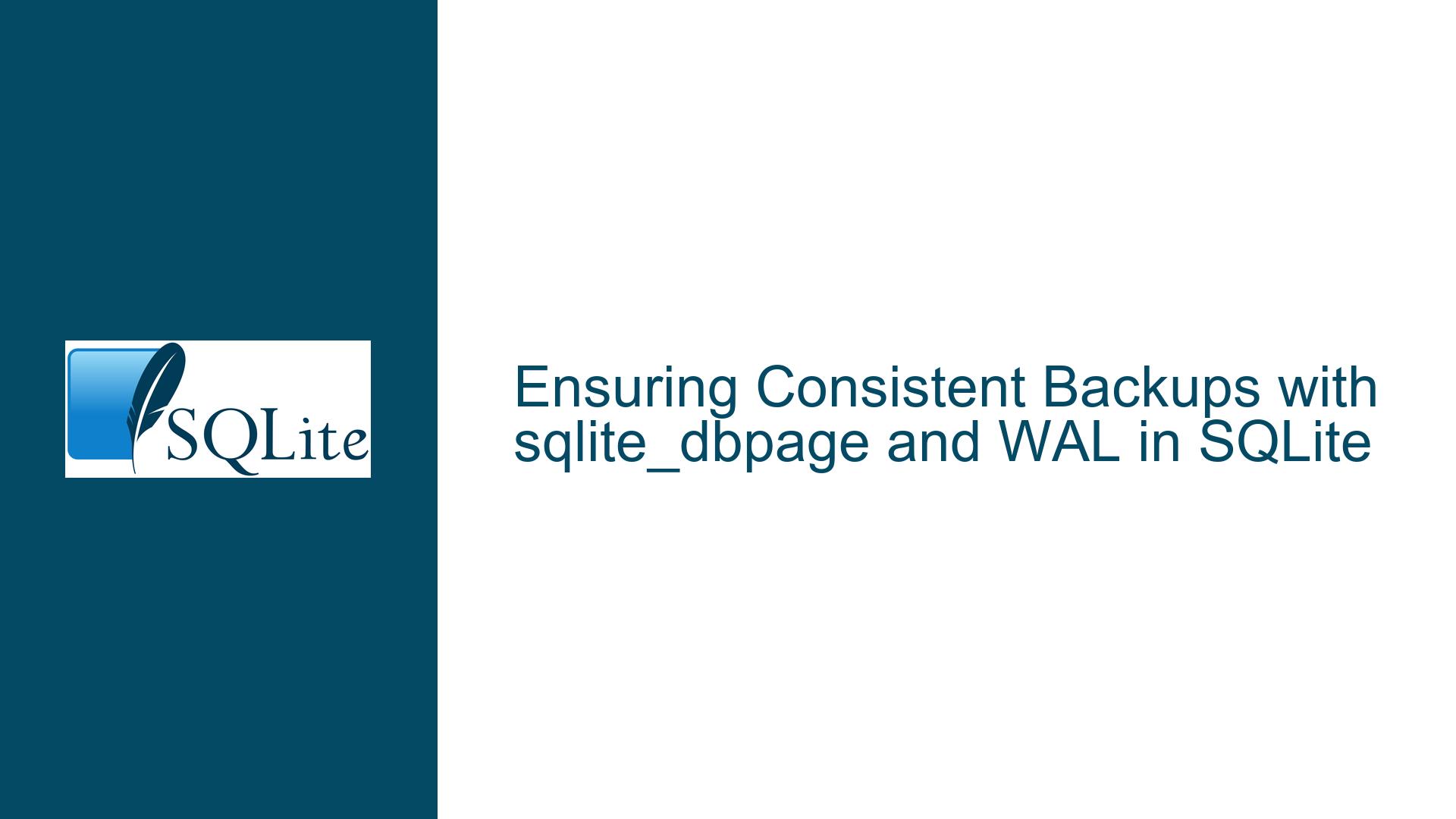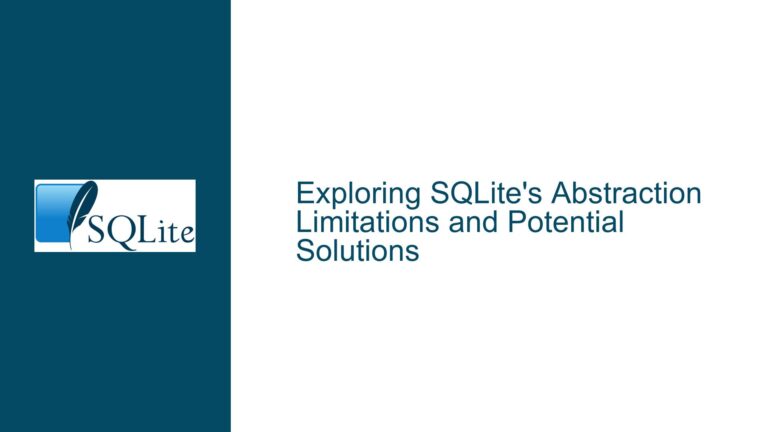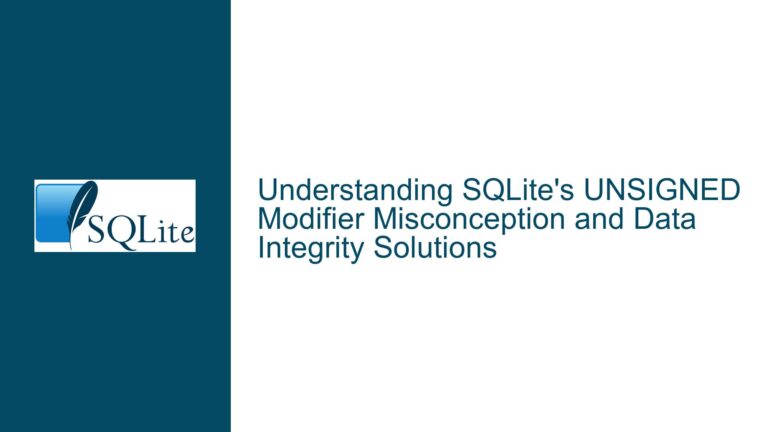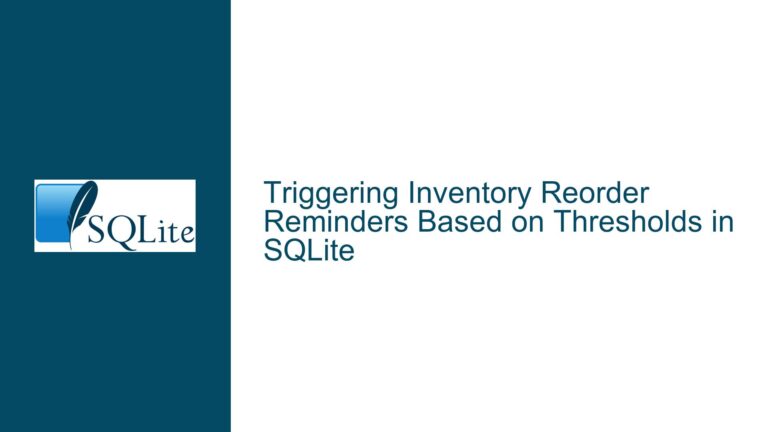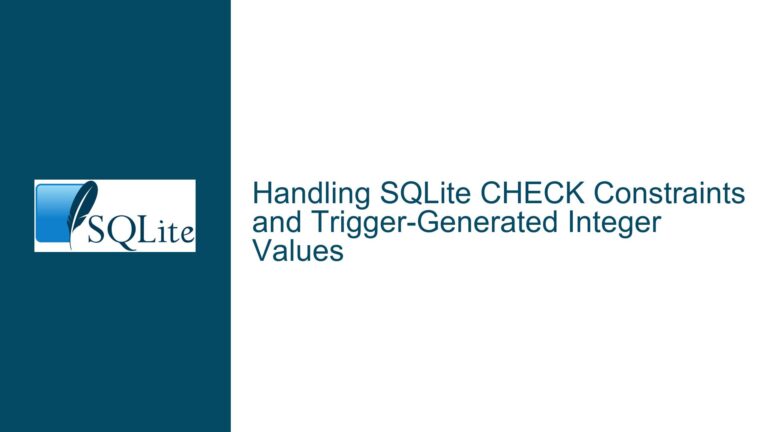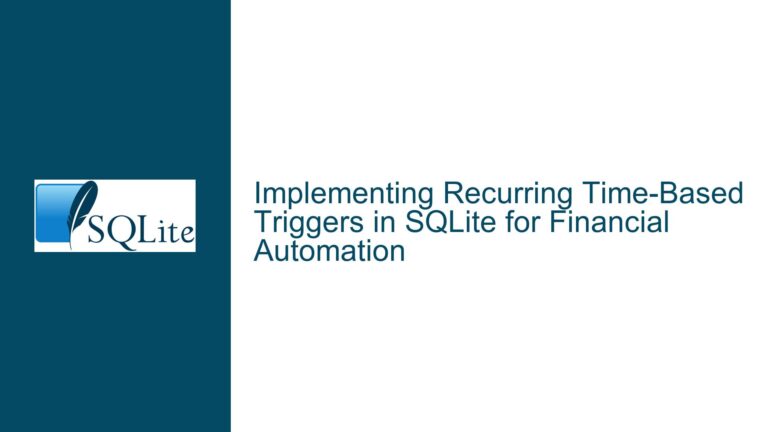Ensuring Consistent Backups with sqlite_dbpage and WAL in SQLite
Understanding the Interaction Between sqlite_dbpage, WAL, and Backup Consistency
The process of creating reliable backups of SQLite databases operating in Write-Ahead Logging (WAL) mode involves navigating subtle interactions between the database file, the WAL file, and virtual tables like sqlite_dbpage. A common challenge arises when attempting to create a point-in-time snapshot of the database by copying pages directly via sqlite_dbpage while simultaneously capturing WAL frames written during or after the backup. The core issue revolves around ensuring that the combination of the copied database pages and WAL frames results in a logically consistent database state, free from corruption or data loss. This requires precise handling of locks, checkpoints, and WAL frame management to avoid race conditions, redundant page writes, or incomplete transaction states.
At the heart of this problem are three critical components:
- The
sqlite_dbpagevirtual table, which provides direct access to raw database pages, including those modified in the WAL. - WAL file dynamics, where active transactions append frames to the WAL before they are checkpointed into the main database.
- Locking mechanisms, particularly the distinction between legacy rollback-mode SHARED locks and WAL read-locks acquired during transactions.
Misunderstanding these components can lead to backups that appear complete but contain logical inconsistencies, such as pages from different transactional states or orphaned WAL frames. For example, copying the main database file while ignoring the WAL might miss uncheckpointed changes, while relying solely on sqlite_dbpage without proper lock management could expose the backup to concurrent modifications. The discussion highlights confusion around whether redundant WAL frames (those already reflected in the database file) are harmless during recovery and how checkpoints invalidate prior backup efforts.
Causes of Backup Inconsistency with sqlite_dbpage and WAL
1. Incorrect Lock Acquisition Leading to Partial Snapshots
A frequent mistake is assuming that a legacy SHARED lock (from rollback mode) provides sufficient isolation for backup operations. In WAL mode, the SHARED lock does not prevent checkpoints or WAL file rotation. Instead, a WAL read-lock—acquired by starting a read transaction (e.g., BEGIN; SELECT FROM sqlite_dbpage;)—is required to freeze the WAL index and prevent checkpoints during the backup. Without this, concurrent writers may checkpoint the WAL while the backup is in progress, causing the copied database pages and WAL frames to represent divergent states.
2. Checkpoint Interference During Backup
Checkpoints are processes that transfer committed transactions from the WAL to the main database file. If a checkpoint occurs after initiating a backup but before completing the WAL copy, the backup’s database snapshot (from sqlite_dbpage) and the WAL may reference overlapping pages. For instance, a page modified in the WAL and checkpointed during the backup could exist in both the main database and the WAL copy. During recovery, SQLite’s WAL playback mechanism may apply redundant updates, but this is generally safe. However, if the backup process restarts after a checkpoint (e.g., "GOTO 2" logic), incomplete handling of the WAL’s salt values (unique identifiers in the WAL header) could lead to mismatches between the database snapshot and the WAL frames, causing recovery failures.
3. WAL Frame Redundancy and Ordering
The sqlite_dbpage virtual table reads the latest version of a page, prioritizing the WAL over the main database. When a backup captures pages via sqlite_dbpage and separately copies the WAL, some pages in the WAL may already be reflected in the sqlite_dbpage snapshot. For example, if a page is modified in the WAL before the backup starts, sqlite_dbpage will return the WAL version, but the backup might also include the WAL frame containing the same modification. During recovery, SQLite ignores duplicate frames, so this redundancy is harmless. However, if the backup process interleaves with new WAL writes, frames added after the sqlite_dbpage snapshot could reference pages not present in the backup’s database copy, leading to inconsistencies unless properly sequenced.
4. Race Conditions in WAL Monitoring
Backup strategies that monitor the WAL for new frames (e.g., using inotify or periodic polling) face timing risks. If a checkpoint occurs between detecting a WAL change and acquiring a read-lock, the WAL file may be reset, invalidating the frames intended for backup. Similarly, without atomic acquisition of the WAL state (e.g., capturing the WAL’s salt values and size atomically), the backup might capture a partial or mismatched set of frames. This is exacerbated in high-concurrency environments where checkpoints and WAL writes occur frequently.
Strategies for Reliable Backups Using sqlite_dbpage and WAL
1. Acquire a WAL Read-Lock via Transaction
To create a stable snapshot, start a read transaction before accessing sqlite_dbpage:
BEGIN;
SELECT * FROM sqlite_dbpage WHERE pgno=1; -- Acquire read-lock
This transaction prevents checkpoints and WAL file rotation until it is committed or rolled back. The read-lock ensures that the WAL index remains fixed, allowing the backup to safely copy both the database pages (via sqlite_dbpage) and the current WAL file. After completing the backup, release the lock with COMMIT or ROLLBACK.
2. Capture WAL Salt Values for Consistency
The WAL header contains two salt values (salt1 and salt2) that change whenever the WAL is reset or checkpointed. During backup:
- Read the salts from the WAL header immediately after acquiring the read-lock.
- Include these salts in the backup metadata.
When restoring, verify that the salts in the backup’s WAL match those expected by the database snapshot. If a checkpoint occurs during the backup, the salts will change, indicating that the backup must be restarted.
3. Handle Checkpoints Gracefully
If a checkpoint is triggered during the backup (e.g., by another process), the backup process should:
- Abort the current backup iteration.
- Discard any partially copied WAL frames.
- Restart the backup from the beginning, acquiring a new read-lock and snapshot.
To minimize checkpoints during backups, configurePRAGMA wal_autocheckpoint=0;temporarily, but ensure it is re-enabled afterward to avoid unbounded WAL growth.
4. Reconstruct the Backup Database Correctly
To restore from a backup created via sqlite_dbpage and WAL frames:
- Create a new database file and populate it with the pages from the
sqlite_dbpagesnapshot usingINSERT INTO sqlite_dbpage(pgno, data) VALUES(...);. - Copy the backed-up WAL file to the new database’s directory.
- Force a recovery by opening the database with
PRAGMA journal_mode=WAL;. SQLite will automatically replay the WAL frames, skipping duplicates and applying the latest valid updates.
5. Monitor WAL Changes Atomically
Instead of relying on filesystem notifications alone, use a combination of PRAGMA wal_checkpoint(TRUNCATE); and salt checks to detect WAL changes. For example:
- After taking a
sqlite_dbpagesnapshot, record the WAL size and salts. - Periodically check if the salts or size have changed. If so, initiate a new backup cycle.
This avoids races where a checkpoint occurs after detecting a WAL change but before locking.
6. Validate Backup Integrity
Use SQLite’s integrity checker to validate the backup:
PRAGMA quick_check;
If errors arise, cross-validate the sqlite_dbpage snapshot and WAL frames:
- Ensure all pages referenced in the WAL exist in the snapshot.
- Confirm that the WAL’s salt values match the snapshot’s expected salts.
7. Optimize for Large Databases
For databases where copying all pages via sqlite_dbpage is impractical:
- Use incremental backups by tracking which pages have changed since the last backup (via WAL frame monitoring).
- Combine periodic full snapshots (using
sqlite_dbpage) with continuous WAL archiving. - Leverage
PRAGMA incremental_vacuum;to reduce the number of pages needing backup after large deletions.
8. Mitigate Redundant WAL Frames
While redundant WAL frames are generally harmless, they can be minimized by:
- Recording the maximum WAL frame index at the start of the backup.
- Only copying WAL frames added after this index during subsequent iterations.
- Using
PRAGMA wal_checkpoint(TRUNCATE);after backup completion to reset the WAL, but only if no other processes are actively writing.
9. Atomic Backup Sequences
Design the backup process as an atomic operation:
- Acquire read-lock and record salts.
- Copy
sqlite_dbpagepages. - Copy WAL frames up to the current size.
- Release read-lock.
If any step fails, discard the partial backup and retry. This ensures the backup represents a single point-in-time state.
10. Edge Case: Concurrent Schema Changes
Schema modifications (e.g., ALTER TABLE) can invalidate a backup if they occur during the sqlite_dbpage copy. To handle this:
- Use
PRAGMA schema_version;to detect schema changes. - If the schema version differs between the start and end of the backup, discard the backup.
By adhering to these strategies, developers can leverage sqlite_dbpage and WAL monitoring to create robust, application-specific backup solutions that match the reliability of SQLite’s native backup API while accommodating custom storage formats or distributed systems. The key is rigorous lock management, atomic state capture, and validation at every stage to mitigate the inherent complexities of WAL-mode backups.
